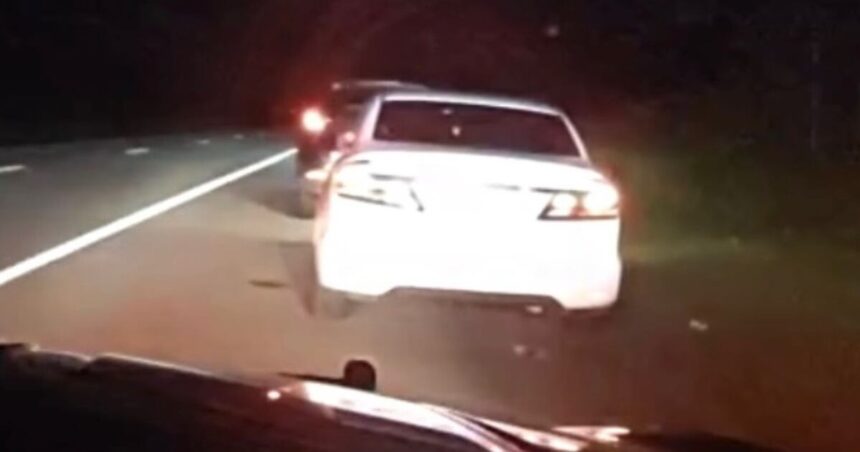In what’s becoming an alarming trend on Ottawa’s highways, Ontario Provincial Police recently intercepted two drivers traveling at dangerously excessive speeds on Highway 417. The incident, which occurred during routine patrol operations last weekend, has reignited concerns about street racing and aggressive driving behaviors that continue to plague the capital region’s major roadways.
According to OPP East Region spokesperson Sergeant Jennifer Smith, officers clocked the first vehicle traveling at 162 km/h in a posted 100 km/h zone near the Moodie Drive interchange. The second driver was recorded at an even more shocking 178 km/h just minutes later.
“What makes this particularly concerning is that these weren’t isolated incidents happening in the middle of the night. These drivers were weaving through regular weekend traffic at speeds that leave absolutely no margin for error,” Smith told me during a phone interview yesterday.
Both drivers, males aged 19 and 24, now face stunt driving charges under Ontario’s Highway Traffic Act. Their vehicles were immediately impounded for 14 days, and both received automatic 30-day license suspensions pending court appearances scheduled for early August.
This enforcement action comes amid growing community frustration about highway safety in Ottawa. City Councillor Riley Brockington, who chairs the Transportation Safety Board, expressed his concern about the ongoing issue.
“Every week, it seems we’re seeing more of these dangerous driving behaviors on our highways. The 417 has become particularly problematic, especially during evening hours and weekends,” Brockington said. “The speeds we’re talking about turn vehicles into deadly weapons.”
The city has recorded a troubling 35% increase in stunt driving charges compared to this time last year, according to data released by the Ottawa Police Service last month. Highway 417, which runs east-west through the heart of Ottawa, has emerged as a particular hotspot.
Traffic safety expert Dr. Teresa Wong from Carleton University points to several factors contributing to this surge in dangerous driving.
“We’re seeing a perfect storm of conditions,” Wong explained. “You have pandemic-related behavioral changes where some drivers became accustomed to emptier roads, combined with social media glorification of street racing, and the psychological appeal of risk-taking behavior, particularly among younger drivers.”
I’ve covered traffic safety issues in Ottawa for over a decade, and this recent spike feels different. The sheer audacity of racing in broad daylight on one of our busiest highways suggests an eroding respect for basic road safety principles that should concern everyone who travels these roads.
Ottawa’s Strategic Road Safety Action Plan, adopted three years ago, identified aggressive driving as a key risk factor requiring targeted intervention. However, implementation of technological solutions like automated speed enforcement has been delayed by budget constraints and jurisdictional complications between municipal and provincial authorities.
Constable Michael Anderson of the Ottawa Police Service’s Traffic Unit told me their enforcement strategy has shifted in response to changing patterns.
“We’re deploying resources differently now, using data to identify the highest-risk times and locations. We’re also working more closely with the OPP to ensure consistent coverage of problem areas that cross jurisdictional boundaries,” Anderson said.
For residents living near Highway 417, the sound of vehicles racing at extreme speeds has become an unwelcome part of daily life. Glebe Community Association president Sarah Mitchell described the impact on neighborhoods adjacent to the highway.
“It’s not just a safety issue, though that’s certainly the primary concern. The noise pollution from modified exhaust systems and engines pushing 7,000 RPM disturbs people’s sleep and quality of life. Our community has filed numerous complaints,” Mitchell said.
The penalties for stunt driving in Ontario were strengthened in 2021 under the Moving Ontarians More Safely Act, with first-time offenders now facing fines ranging from $2,000 to $10,000, potential jail terms up to six months, and license suspensions of up to three years upon conviction.
Despite these enhanced penalties, deterrence remains challenging. Traffic psychologist Dr. Raj Mehta from the University of Ottawa suggests the solution requires more than just enforcement.
“The human brain, particularly in younger adults, often underestimates risk while overestimating driving skill. Effective intervention needs to combine strict enforcement with education that addresses these cognitive biases,” Mehta explained during our recent conversation at his campus office.
The OPP and Ottawa Police Service have announced plans for increased joint operations targeting street racing and aggressive driving throughout the summer months, with particular attention to Highway 417 and other high-speed corridors.
Sergeant Smith emphasized that public participation remains vital. “We encourage drivers to report dangerous driving behaviors safely by having passengers call our non-emergency line or pulling over to make a report. Dashcam footage has become increasingly valuable evidence in these cases.”
As I drove along that same stretch of Highway 417 yesterday, observing the normal flow of traffic moving at reasonable speeds, it was difficult to imagine vehicles tearing through at nearly 80 km/h above the limit. Yet the evidence shows this dangerous behavior continues, presenting a critical public safety challenge for our community and law enforcement alike.







